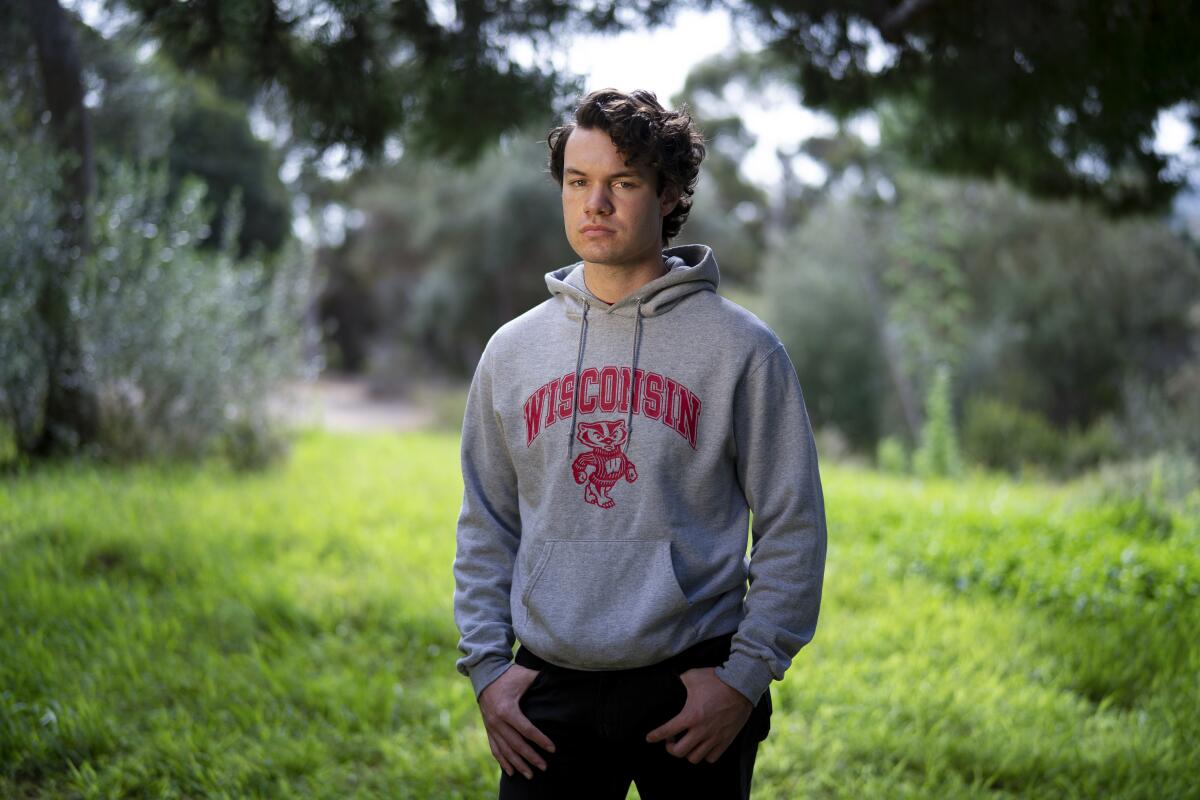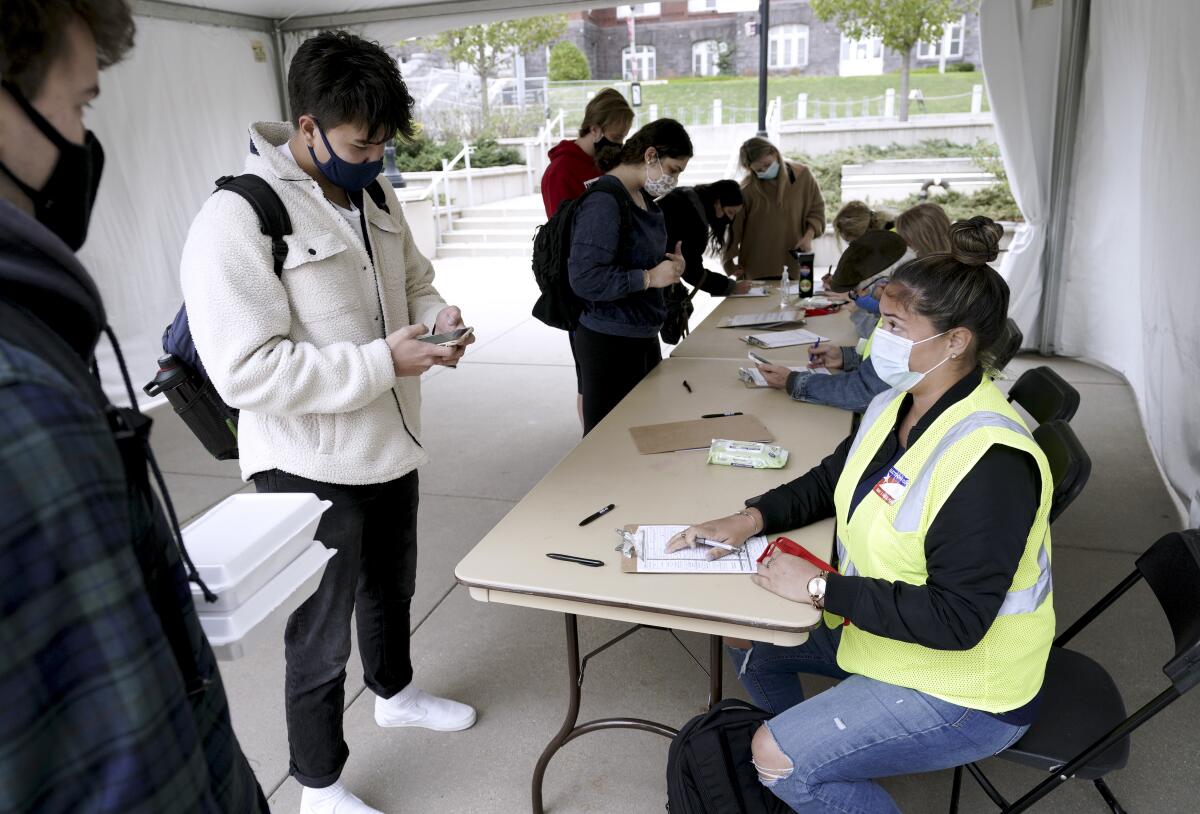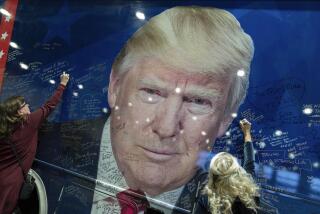Many college students hoped to vote in swing states. Then the COVID-19 pandemic sent them home

MADISON, Wis. — Bryce Neels grew up in San Diego, but when it came time for college, he chose the University of Wisconsin for its strong sense of community, its well-regarded professors and its fanaticism for sports.
As he grew interested in politics and increasingly disillusioned with President Trump, he soon discovered another plus: Wisconsin is a swing state.
“It was ideal,” said the 21-year-old junior, “because I knew my vote would count more in Wisconsin than in California.”
But then the coronavirus arrived.
When his sprawling campus here shuttered in March, Neels moved back in with his parents in San Diego. He’s still living there now, working part-time at Target and attending classes on Zoom.
Without a Wisconsin address, he had no choice but to cast his first presidential ballot in California, where Democratic nominee Joe Biden is expected to win the state in a landslide.
“I would have loved to have voted in Wisconsin, but for safety reasons, being home this fall just felt right,” Neels said.
College campuses have long been hubs of liberal political activism and get-out-the-vote efforts — catalysts that have helped Democrats win elections in swing states.
In Wisconsin, Michigan and Ohio, the weeks leading up to an election day typically bring door-to-door campaigning and massive voter registration drives at football tailgates.
Students can also be a powerful voting bloc in their own right, with those from out-of-state significantly bolstering the ranks.
But as the pandemic flared over the summer and early fall and classes moved online, normally bustling campuses thinned out, drastically changing the calculus of ground-game operations as Nov. 3 nears.
Nationwide, colleges and universities saw a 4% drop in enrollment this fall, according to the National Student Clearinghouse Research Center. Here in the Midwest, home to several swing states, that figure was about 6% — a decline that could matter on election day.
“In a tight race, the absence of college students could easily tilt a state,” said Nathan Gonzales, editor of Inside Elections, a nonpartisan group that analyzes federal and state contests. “Just like suburban women, or rural voters, every vote matters.”
In Wisconsin, about 345,000 college students make up nearly 7% of the state’s eligible voting population, according to the Institute for Democracy & Higher Education at Tufts University.
During the 2018 race for governor here, the institute found, counties with large numbers of college students strongly supported Tony Evers, a Democrat, while those without many favored incumbent Republican Gov. Scott Walker, who ultimately lost by 29,000 votes.
The institute also ranked Wisconsin as a state where young voters would be most likely to decide the 2020 presidential election.
“Students want to vote where their vote matters,” said Nancy L. Thomas, who heads the institute. “And they turn out at much higher rates when that is the case.”

Madison — a hub for the anti-Vietnam War protests in the 1960s — is a bastion of left-leaning politics, in contrast to more rural, conservative parts of the state.
The university’s politics have been part of the draw for many out-of-state students, who make up half of the 45,000 people enrolled.
Students returned to campus in late August, but soon classes went online-only again as coronavirus cases skyrocketed. Since the start of the fall semester, about 3,300 students have contracted the virus and school leaders have encouraged students to take classes remotely.
This month, some in-person courses resumed as cases decreased.
But the campus has been quiet. During homecoming last week, students participated in virtual concerts and pep rallies ahead of the football showdown with the University of Illinois.
With no fans permitted, the two teams played in an empty stadium.
The next afternoon, crisp and overcast, a steady stream of masked students walked across Library Mall to a coffee shop inside the student union.
Outside, a white tent housed machines for early voting. In the span of an hour, roughly a dozen students dropped by to cast their ballots.
“Registered to vote in Wisconsin?” a volunteer asked a student passing by.
“No,” the student said, shaking her head, without breaking her stride.
There is little doubt that Biden will win Dane County — which includes the university — but the students hope to run up the margin of victory. Trump, who trails Biden in statewide polls, won Wisconsin by just 22,000 votes four years ago.
Kade Walker, a spokesman with NextGen America, a left-leaning group that organizes and registers voters in Madison and elsewhere, said the pandemic has made his work harder.
The face-to-face conversations that he said were critical to registering voters here in 2018 are no longer possible, leaving social media as the main way to connect with students.
“The switch from in-person organizing to an all-digital program wasn’t without growing pains,” he said. “But young activists have proven their determination to generational change, and they have found a way to continue the conversations that led us to victory in 2018.”
Meanwhile, Badgers Vote Coalition, the university’s nonpartisan voter education initiative, has transformed its traditional “Rock the Vote” event into “Zoom the Vote,” which includes instructional videos on absentee ballots and how to get a gig as a poll worker.
“We are using humor and students’ online networks to make sure they have everything they need to vote,” said Katherine Cramer, a UW-Madison political science professor and co-chair of the coalition.
More than 1.3 million people — including nearly 100,000 in Madison — have cast early ballots in Wisconsin.
Grace Hodgman, a junior majoring in journalism, had intended to do the same.
But she left campus in March and hasn’t returned, instead taking her 15-credit-hour course load from her parents’ home in northern Virginia, while also juggling her responsibilities as a full-time copy editor for the Daily Cardinal, the university’s daily newspaper.
“For me and my parents, safety was No. 1,” she said. “We’re in a global pandemic.”
Hodgman, a Democrat, cast her ballot for Biden in Virginia, a state that was once thought of as a toss-up, but now is increasingly solid turf for Democrats.
She said she viewed her vote as a repudiation of Trump’s handling of the pandemic, as well as his unwillingness to call out Russia for its interference in the 2016 election.
Back in San Diego, Neels has been closely following the presidential race — and thinking about the outsized influence of Wisconsin.
He said his interest in politics began to deepen this summer in the weeks after the death of George Floyd in police custody in Minneapolis. He watched with admiration as protests for racial justice spread across the country, and he said he often thought about how rhetoric from the White House isn’t easing tensions.
“That’s not happening now,” he said. “But it should be happening.”
He talks to friends on campus and not too long ago some of his parents’ friends teased him about being home in California.
“They said, ‘What are you doing voting here? You need to be in the swing state,’” Neels said.
“Any other election year, I would have been there,” he said. “But 2020 is clearly different.”
More to Read
Sign up for Essential California
The most important California stories and recommendations in your inbox every morning.
You may occasionally receive promotional content from the Los Angeles Times.











